There are mainly two types of method to harvest energy from
tide. The first on is tidal stream generator. The second kind is tidal
barrage. There are another two kinds of
proposed methods including dynamic tidal power and tidal lagoon. Because these
are pure mechanical device with no heat transformation and reduced energy
transformation process, efficiencies are higher than traditional power plant.
Tidal power is more predictable than wind and solar power. Even though tide
power plant cannot generate electricity all the time. It can capture tide
energy for roughly 10 hours per day. Problems associate with tide power are
that most of tide power plant will be built at remote area. Electricity being
generated needs to be transported through long distance in order to reach
populated area. Time integral that tide power plants generate power is not peak
electricity usage hour. Electricity energy needs to be stored in some other
form which is a challenge for current technology (Siegel, 2012).
Pros of tidal power (Siegel, 2012):
·
Renewable
·
Emission-free
·
Reliable (power plant can last over 100 years)
·
High efficiency
·
Predictable output
·
Could potentially provide a storm surge barrier.
Cons of tidal power:
·
Expensive to build.
·
Location specific (only able to build at place
with high tide difference)
·
Technology challenge for storing energy that
being produced
·
Change tide height for surrounding area and
disrupt regular tidal cycle
·
Environmental impact on surrounding area
·
Slow down costal ocean current which may lead to
dirt, waste build up
Tidal stream generator utilizes kinetic energy of moving
water to power turbines. Tidal turbines are freestanding machines that spin
with water pass through. It is similar to winder powered turbines, but tide
power hydroelectric plants are more predictable. Some turbines can be installed
on current existing infrastructures such as bridge. Many types of tidal stream generators are
available for use. Most popular one is axial turbines. Its shape is close to
traditional windmills. Cross-flow turbines have the advantage that able to be
installed either vertically or horizontally (“Tides”). Flow augmented turbines
theoretically produce more energy than traditional windmill turbines. These
generators are normally deployed where ocean current is strong therefore higher
amount of electricity can be produced.
Second type of popular method is tidal barrage. It is like a
dam which captures energy from current flow by. Normally tidal barrages are
being built near mouth of river or bay. When sea level rises, water rushes into
the river or bay. When tide is gone, a potential difference created. Water with
high potential is released back into ocean. Water body flows huge turbines to
create electrical power though large generator.
Dynamic tidal power is a proposed method that may able to
produce electricity. It utilizes the potential energy with kinetic energy. A
long T shape dam into the ocean will create phase difference for wave at
shallow water. The significant water level difference may able to be utilized
and converted into electricity (Evans, 2007).
Tidal lagoon proposes to construct a circular wall that will
hold large body of water. It will let in water when high tide comes and use
water’s high potential energy difference to produce electricity.
Citation:
Hulsbergen, K., R. Steijn,
G. Van Banning, and G. Klopman. Dynamic
Tidal Power – A New Approach to Exploit Tides. 2008. Print.
Evans, Robert.
"Fueling Our Future: An Introduction to Sustainable Energy." New York: Cambridge University Press (2007). Print.
"Tidal." Welcome to Tethys. U.S.
Department of Energy. Web. 1 Dec. 2014.
<http://tethys.pnnl.gov/technology-type/tidal>.
Siegel,
RP. "Tidal Power: Pros and Cons." Triple
Pundit RSS. 1 June 2012. Web. 1 Dec. 2014. <http://www.triplepundit.com/2012/06/tidal-power-pros-cons/>




No comments:
Post a Comment